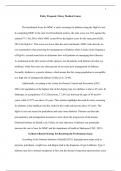1
Policy Proposal: Mercy Medical Center
The benchmark focus for MMC is early screening for diabetes using the HgbA1c test.
In comparing MMC to the state level benchmark metrics, the state score was 70.4 against the national 71.3 for 2019, while MMC scored 60 as the highest score for the same period (Q3, 2019) for HgbA1c. This score was lower than the state benchmark. MMC relies heavily on eye examination when assessing for management of diabetes while it slacks in the frequency of HgbA1c second-round tests to determine how well patients are managing their illnesses. As mentioned in the first section of this analysis, not all patients with diabetes develop eye problems, while foot sores are often present on severely poor management of diabetes. Secondly, diabetes is a genetic disease, which means that the young population is susceptible to a high risk of undiagnosed diabetes (Udler et al., 2019).
Additionally, according to the Center for Disease Control and Prevention (CDC, 2021), the population at the highest risk of developing type two diabetes is above 45 years. In
Shakopee, in a population of 35,328 persons, 17.26% are between the ages of 45-and 64 years, while 23.97% are above 45 years. This statistic highlights the need for early screening for diabetes at the healthcare facility, both for the youth and persons above 45 years. The HgbA1c test can screen for prediabetes and early-onset diabetes. Patients can then take precautionary and management measures to slow down the progression of the disease (National Institute of Health, n.d). Failure of early detection of diabetes can potentially increase the cost of care for MMC and the department of health at Shakopee (CDC, 2021).
Evidence-Based Strategy for Resolving the Performance Issue
According to the National Institute of Health (2021), hyperglycemia signs such as polyuria, polydipsia, weight loss, and fatigue lead to the diagnosis of type I diabetes. Type 2 diabetes may have minimal symptoms at first, but the disease's long-term repercussions cause 2
a slew of different issues, leading to devastating consequences later on. Due to its early silent course, type two diabetes often goes undiagnosed for an extended period before symptoms arise. The goal of disease screening is to prevent and treat the disease early, believing that detecting it early in the disease process has a long-term benefit. The US Preventive Services Task Force recommends screening overweight or obese people aged 40 to 70 for diabetes and
repeating testing every three years if the results are typical. More early/frequent screening, early behavior intervention, and rigorous treatment are necessary for people with a high risk of developing diabetes. Patients with obesity and other major risk factors for diabetes may have a shorter interval (National Institute of Health, 2021). The American Diabetes Association promotes diabetes screening in adults 45 years and older and screening in those with multiple risk factors of any age (National Institute of Health, 2021).
MMC will ensure screening for all young patients with a family history of diabetes as part of the general care. The clinic will conduct screening for any patient aged over 45 years, pregnant woman, and any person outside of these categories but is at high risk. The clinic will
ensure education of patients who are not fluent in English, on the need for the screening tests.
The clinic will also have posters in the ER and every physician's office informing patients that the mentioned categories of persons get a free diabetes test. The clinic will have reading material in English and Spanish that patients can pick and get information on diabetes, including the need to get screened and how to avoid developing the disease.
Potential Effects of Environmental Factors.
The physical, social, and psychological environment in which individuals live and conduct their lives comprises environmental factors. Environmental variables are external to the individual and can positively or negatively impact a person's ability to participate in society, conduct activities, or maintain body function and structure. In this case, the environmental factors affecting the new regulation are primarily physical and attitudinal.




